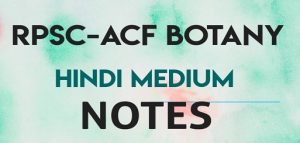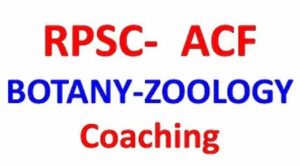इस परीक्षा के लिए आधार इंस्टिट्यूट में सिर्फ बॉटनी और जूलॉजी विषयों की ही कोचिंग दी जाती है यह दोनों ही विषयों के वीडियोस लगभग तैयार हैं और इनकी वीडियो आप हमारी मोबाइल एप्लीकेशन iGuruji को google playstore से डाउनलोड करके देख सकते हैं
1- A candidate for the Rajasthan Forest Service must take all the compulsory subjects and any two of the optional subjects listed below. The time allowed for each paper shall be three hours.
(I) Compulsory subjects :
Marks
1- General Knowledge 100
2- General English 100
(II) Optional Subjects :
Any two subjects out of the following – 200 marks (each)
- Agriculture 2. Botany
- Chemistry 4. Computer Application/Science
- Engineering (Agricultural/Chemical/Civil/Computer/Electrical/Electronics/Mechanical)
- Environmental Science
- Forestry 8. Geology
- Horticulture 10. Mathematics
- Physics 12. Statistics
- Veterinary Science 14. Zoology
OPTIONAL SUBJECT – ZOOLOGY
- Biodiversity, concept of species and taxonomical hierarchy, concept of five kingdom system, International Code of Zoological Nomenclature, tools for study of taxonomy – Museums and Zoos. Basis of classification of non- chordates and chordates : symmetry, coelom, segmentation and embryogeny.
General features, adaptations and life history (Paramecium, Plasmodium, Leishmania, Sycon, Obelia, Taenia, Fasciola, Ascaris, Nereis, Pheretima, Periplaneta, Apis, Lamellideus, Pila, Asterias)
- Origin of chordates, general features and life history of Branchiostoma, Herdmania (Ascidian tadpole larva) & Petromyzon (Ammocoete larva). Comparative functional anatomy of various systems of vertebrates [Integument & its derivatives, digestive system, respiratory system, circulatory system including heart and aortic arches, urinogenital system, brain & sense organs (eye & ear)]
Chordate adaptations : Scales & fins, migration & parental care in Pisces, parental care in Amphibia. Poisonous & non poisonous snakes, poison apparatus, flight adaptations, bird migration. Adaptive-radiation, dentition in mammals.
- Structure and function of cell and its organelles (Plasma membrane, mitochondria, golgi bodies, endoplasmic reticulum, ribosome’s, lysosomes, nucleus), cell division (mitosis & meiosis), mitotic spindle and mitotic apparatus, chromosome movement.
Chemical constituents of living cells : Biomolecules, structure and function of proteins, carbohydrates, lipids & nucleic acids.
Enzyme : Types, Properties & enzyme action. Vitamins.
- Metabolism of carbohydrates : Glycolysis, Krebs’ cycle, oxidative phosphorylation, interconversion of glycogen & glucose in liver.
Metabolism of protein : Deamination, transamination, decarboxylation. Synthesis of protein & urea, Ornithine cycle, fate of carbon skeleton.
Metabolism of lipids: Beta-oxidative pathway of fatty acids, brief account of biosynthesis of triglycerides, cholesterol & its metabolism.
Metabolism of nucleic acids.
- Physiology with special reference to mammals. (Physiology of digestion, blood circulation, respiration, excretion, muscle contraction & nervous system).
Types of endocrine glands, their secretions & functions: pituitary, adrenal, thyroid, pancreas, testis and ovary.
Hormonal control of male and female reproduction, implantation, parturition and lactation in mammals.
Preliminary ideas of neurosecretion, hypothalamic control of pituitary function.
- Mendelian Inheritance and genetic interactions, genetic code.
Linkage and crossing over, sex determination in Drosophila & human beings cytoplasmic inheritance, multiple gene inheritance.
Chromosomal mutations and mutagens, genetic disorders in humans.
Natural selection, mimicry, isolation & speciation.
- Gametogenesis: Formation of ova and sperms, vitellogenesis, fertilization, parthenogensis, cleavage, blastulation, morulation.
Fate maps, morphogenetic movements, gastrulation, embryonic induction, differentiation and competence.
Embryonic adaptations: Extra-embryonic membranes in chick and placentation in mammals.
Metamorphosis in Amphibia, paedogenesis, neoteny, regeneration, teratogenesis, biology of aging, cell death.
- Ecosystem, biogeochemical cycles, population ecology, community ecology, ecological succession, fresh water and desert ecology with special reference to Rajasthan.
Environmental biodegradation: Pollution and its impact on biosphere and its prevention.
Conservation of natural resources: Mineral mining, aquaculture, forestry, wild life Sancturies, National Parks, Hotspots. Animal distribution with special reference to Rajasthan.
Principles and practices of the following: Vermiculture, Lac culture, Apiculture, Poultry culture, Pisciculture, Pearl culture.
Economic importance of Protozoa, corals and coral reefs, Helminthes, Arthropods, insects and their management.
- Animal Behaviour: Feeding, learning, instinctive, motivated, social and reproductive.
Methods of studying animal behaviour.
Biostatistics: Mean, mode, median, standard deviation, Probability.
- Immunology: Types of immunology, organs of immune system, antigen- antibody reactions.
Immunity regulating cells, mechanism of humoral and cell mediated immunity. vaccines, pathogens and parasites.
Definition, scope and application of biotechnology, recombinant DNA technology, human genome project.
Brief concept of animal cell, tissue, organ and embryo culture, transgenic animals.
Note :- Pattern of Question Pape
- Objective type paper
- Maximum Marks : 200
- Number of Questions : 120
- Duration of Paper : Three Hours
- All questions carry equal marks.
- There will be Negative Marking.
OPTIONAL SUBJECT – BOTANY
- Plant viruses : General structure, classification and replication. Mycoplasma and Phytoplasma – Biology and economic importance.
Bacteria : Ultra-structure, classification, reproduction/ genetic recombination, and economic importance, Archebacteria-general account.
Algae: General characters of major groups of algae, their classification, reproduction and economic importance.
Fungi: General characters, cell wall composition, nutrition, classification, (Alexopoulos and Mims, 1979) reproduction and economic importance of major groups of fungi. Important plant diseases: Little leaf of Brinjal, Citrus canker, Black Rust of wheat.
- Bryophyta – General characteristics, classification, thallus organization and evolution, reproduction and economic importance.
Pteridophyta: General characteristics, classification and alternation of generations.
- General characters and classification of Gymnosperms : their life-cycle and economic importance.
Classification of Angiosperms : salient features of system of classification proposed by Bentham Hooker. Type concept, binomial system of nomenclature and principle of priority.
Diversity of angiosperm plants as illustrated by the members of families Ranunculaceae, Fabaceae, Apiaceae, Asteraceae and Poaceae. Important herbaria and botanical gardens of India and World. Role of BSI in Inidia.
- Morphology of root, stem and leaves of Angiosperms. Types of inflorescence, flower as a modified Shoot.
Tissue system : Primary and secondary tissues, simple and complex tissues, normal anatomical features of monocot and dicot stem, root and leaves. Vascular system-types of vascular bundles, apical and cambial meristem. Origin of lateral roots.
General account of wood-characteristics of growth rings, sapwood and heart wood, periderm. Normal secondary growth in dicot root and stem. Anamolous type of secondary growth in Boerhavia, Leptadenia, Salvadora, Baugainvillia, Dracaena.
Pollination, development of male and female gametophytes, types of ovules. Double fertilization, types of embryo sacs, development of embryo in dicots. Endosperm types. Structure of dicot and monocot seeds.
- Utilization of plants : Source, cultivation, improvement in plants of economic value and human welfare with special reference to cereals crops (Wheat, Maize, Bajra).
Important oil-seeds (Groundnut, mustard) and seed spices (coriander fenugreek, cumin) Important fibre crops (Jute, Cotton).
Important medicinal plants, cultivation and utilization with special reference to Withania, Commiphora, Plantago.
Forest resources: Timber (Tactona, Dalbergia, Tecomella), Gum and oleo-gum resin yielding plants (Acacia, Anogeissus, Boswellia, Butea, Commiphora). Minor forest produce-Diospyros and Dendrocalamus. Brief account of ethnobotany with special reference to Rajasthan.
- Plants and Environment- Atmosphere, water, light, temperature, soil (development, profile and physical-chemical characteristics of soil). Plant adaptation in response to environment (Hydrophytes, Xerophytes and Halophytes).
Ecosystems – Structure, abiotic and biotic components, food chain, food web, ecological pyramids, energy flow and biogeochemical cycles (carbon, nitrogen and phosphorus)
Ecotypes, ecads, community characteristics, frequency, density, abundance and cover. Ecological succession.
Phytogeography – Phytogeographical regions of India, vegetation types of India-Forests and grasslands. Vegetation of Rajasthan. Plant conservation strategies-in situ and ex situ conservation.Red Data Book and IUCN classification. Endangered and threatened plants of Rajasthan.
- Plant water relations : Physical properties of water.Diffusion and osmosis, Transpiration, physiology of stomatal movement. Essential macro- and micro-elements and their role in plant growth.
Photosynthesis : Photosynthetic pigments, concept of two pigment system, photophosphorylation, carbon cycle, C3 and C4 pathways, CAM plants.
Respiration : Aerobic and anaerobic respiration, Kreb’s cycle, electron transport system, Oxidative phosphorylation Pentose phosphate pathway. Fermentation.
Plant Growth Regulation : Phases of growth. Seed germination and factors affecting the process. Concept of photoperiodism and vernalization. Plant Growth Regulators, their synthesis and physiological functions with special reference to auxins, gibberellins, cytokinins, ABA and synthetic plant growth regulators.
- Cell Biology : Prokaryotic and Eukaryotic cells, Structure and functions of important cell organelles.
Ultra-structure and functions of chromosomes, Chromosomal abberations. Polyploidy cell-cycle, mitosis and meiosis.
Concept of heredity, Mendel’s laws of heredity. Linkage, structure of gene, transfer of genetic information, transcription and translation. Mutation- spontaneous and induced.
Plant breeding : Domestication, introduction acclimatization, selection and improvement.Plant breeding methods-emasculation, hybridization, test cross, back cross, hybrid vigour (heterosis) .
- Nucleic acids : DNA and its structure, replication, functions. Types of DNA. Extra chromosomal DNA (mitochondria, chloroplast and plasmids). RNA-its structure, types and functions.
Gene regulation and expression in prokaryotes and eukaryotes. Mechanism of protein synthesis, protein structure and function.
Tools and techniques of recombinant DNA technology.Gene isolation, cloning, introduction and expression. Cloning vehicles-plasmids, cosmids, phages, methods of gene transfer in plants (direct and indirect methods).
cDNA library, genomic library, transposable elements, DNA finger printing, genetic mapping.
- Concept of asepsis and methods of sterilization. Physical and chemical methods of sterilization (Autoclave,Oven, UV radiations, Surface disinfectants, HEPA filtration, Laminar flow Clean Air Bench).
Tissue Culture Media. Chemical composition (Macro- and micronutrients, Vitamins, Carbon source, amino acids and PGRs) of different media viz. Murashige and skoog’s medium, white’s medium and Shenk and Hildebrandt’s medium. Methods of their preparation.
Concept of cell totipotency in plants. Types of Culture- callus culture, suspension culture, single cell culture, organ culture. Ex-plant preparation, sterilization and inoculation. Methods of in-vitro plant propagation. Callus organogenesis and somatic embryogenesis.
Strategies for production of transgenic plants with special reference to herbicide tolerance and insect resistance. Transgenic crops such as Bt cotton, Bt Brinjal, Round-up Ready Soyabean.
Note :- Pattern of Question Paper
- Objective type paper
- Maximum Marks : 200
- Number of Questions : 120
- Duration of Paper : Three Hours
- All questions carry equal marks.
- There will be Negative Marking.
You can pay directly on ,
Phone pe 9314503070
Google pay 9314503070
Paytm 9314503070
Or
BHIM 9314503070@upi
Or
In Favour Of “Aadhar forum“
IFSC: PUNB0587400
Current account no. 4066002100006375
BANK BRANCH : Punjab National Bank,
BARKAT NAGAR, JAIPUR-302015



